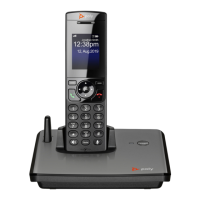Call Routing
38
●
**1(Msp1)
– Matches any number that starts with **1 and with the rest of digits matching the
DigitMap in the SP1 Service.
●
<:1234>
– Matches an empty phone number and replaces with 1234. This is the syntax for a hotline
to 1234.
●
<S0:1234>
– Equivalent to the last example.
●
<:#>
– Hotline to the number #.
●
<S0:#>
– Equivalent to the last example.
●
<S4:1234>
– Call 1234 if no digits entered for 4 seconds. This is the syntax of a warm line.
●
xx.853 7683
– Matches any number with at least 8 digits and ends with 8537683, such as
15108537683, 98537683.
●
(x.408 223 1122)
– Matches any number with at least 10 digits and ends with 408 223 1122,
such as 4082231122 or 1408 223 1122.
●
xx.<#>
– Adds a # to the end of any number with 1 or more digits.
●
!1900xxx xxxx
– Barring all 11-digit numbers that start with 1900.
●
[^*]@@.
– Arbitrarily long alphanumeric sequence (except #) that doesn’t start with *
●
xx?
– Any 1- or 2-digit number.
●
(1xxxxxxxxxxS0|xx.)
– Arbitrarily long digit sequence not starting with 1. Otherwise it is limited to
11 digits.
Matching Against Multiple Rules in a Digit Map
One important function of a digit map is to determine if you dialed sufficient digits during dialing. A digit map
normally contains more than one rule. The Digit Map Processor (DMP) must return the best matched rule
at some point, or declare that the input digit sequence is invalid. The DMP keeps refining its decision as
each digit is entered until it reaches a final decision, or is forced to make a timely decision when the interdigit
timer expires.
The DMP restarts the interdigit timer on every newly entered digit. The duration of this timer can be either
long or short. The long and the short timer values are set by default to 10 seconds and 2 seconds,
respectively, and are configurable per handset via the DigitMapLongTimer and DigitMapShortTimer
parameters. Whether to use the long or short interdigit timer depends on the current rule matching states.
The DMP maintains a matching state for each rule in the digit map as it processes each input digit. The
following states are defined:
● Partially Matched (PM) – The rule partially matches the accumulated input sequence. Initially all rules
are in this state before any digit is entered. Rules in this state have the potential of becoming EM or
IM as more digits are entered. Example: 1234 partially matches the rules xxxxxxx, 1xxxx,
1234567, <123:>xxxx.
● Exactly Matched (EM) – The rule exactly matches the accumulated input sequence. However, any
further input digit turns this rule into the MM state. Example: 1234 exactly matches the rules xxxx,
1234, 1xxx, <123:5678>x.
● Indefinitely Matched (IM) – The rule matches the accumulated input sequence indefinitely, with a
variable length such that the rule can potentially stay as IM as more matching digits are entered.
Example: 011853 indefinitely matches the rules xx., 011xx., <011:>xx.
● Mismatch (MM) – The rule doesn’t match the accumulated input sequence. This state won’t change
as more digits are entered. Example: 1234 mismatches the rules 123, 1xx, 12345.

